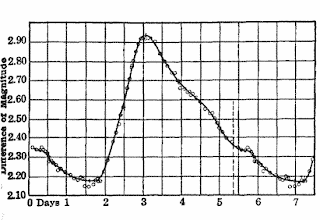 ness) of the stars. As all of the stars in the SMC were basically the same distance away from Earth, the variations in luminosity were proportional to the intrinsic brightness of the stars. Meaning that it was not necessary to determine the distance of the individual stars to demonstrate that there was relationship between period and luminosity - period / luminosity relation (PL relation). The stars that Levitt studied were Cepheid variables. The diagram above shows the light curve of one of the Cepheids that Levitt studied.
ness) of the stars. As all of the stars in the SMC were basically the same distance away from Earth, the variations in luminosity were proportional to the intrinsic brightness of the stars. Meaning that it was not necessary to determine the distance of the individual stars to demonstrate that there was relationship between period and luminosity - period / luminosity relation (PL relation). The stars that Levitt studied were Cepheid variables. The diagram above shows the light curve of one of the Cepheids that Levitt studied.
This discovery indicated a method of measuring astronomical distances. Once the PL relation for Cepheids was established it would be possible to determine the absolute luminosity of a Cephid and by comparing absolute and apparent magnitudes to determine the distance to the star. Hubble used Cephids to show that there were many galaxies beyond our own and that the galaxies were moving away from each other ie that the universe was expanding. Eventually the Space Telescope that bears his name was able to determine the distances of galaxies as far away as 20 million light years using Cepheid variable stars.
There were many difficulties in calibrating the PL relation for Cepheids, and it was many decades before a reasonably accurate determination was made.
The rest of the post covers in some technical and mathematical detail the processes involved in determining a value for the PL relation, which enabled the modern measuring of distances in the millions of light year range.
The PL relation is usually written as: M = a + blog10P, where P is the period, M is the intrinsic magnitude (luminosity), a is a constant (the zero point) and b is the gradient of the relation.
The problem facing astronomers was to determine the values of the zero point and the gradient. One of the problems with the initial calibration attempts was that there are more than one variable star. The early calibrations included RR Lyrae stars, W Virginis stars as well as Cepheids. It took more that 20 years to clear up this confusion.
There were also difficulties with some of the techniques available. During Levitt's time and for many decades afterwards, photographic plates were used to measure the variations in the intensity of the stars. This was problematic for two reasons: 1) photographic plates are non linear and therefore produced incorrect measures of magnitude variation (fluxes), and 2) most of the light registered on photographic plates was from the blue wavelengths which is strongly absorbed by inter-stellar dust.
Measuring absolute distances to even close Cepheid variables was very difficult at they were too far away for accurate parallax measurements for much of the 20th Century.
In recent decades improved techniques (such as charged coupled devices) have improved the measurement of fluxes. The Hipparcos satellite has allowed improved measurement of distances to Cepheids. These technical developments have made possible the reasonably accurate determination of the PL relation. The modern value is:
1 comment:
If the Europeans can stop arguing and get the Gaia sattelite up we could get to the centre of the galaxy and will detect the peoper motion around the one or more black holes. Also it will pick up many cepheids.
Post a Comment